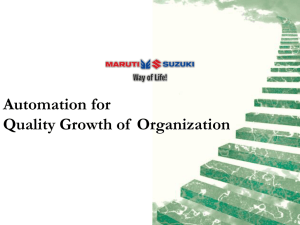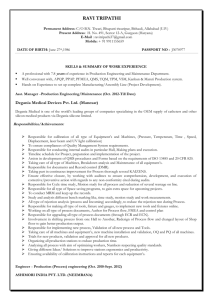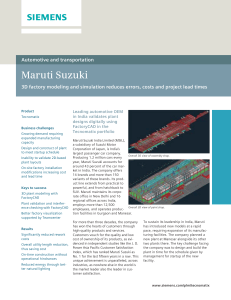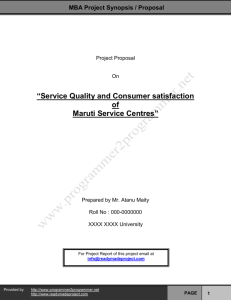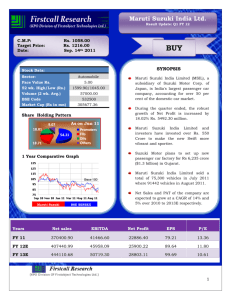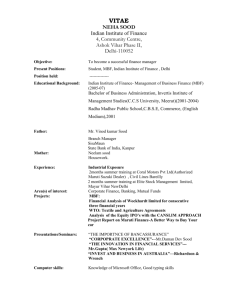Case Study of Maruti Suzuki
advertisement
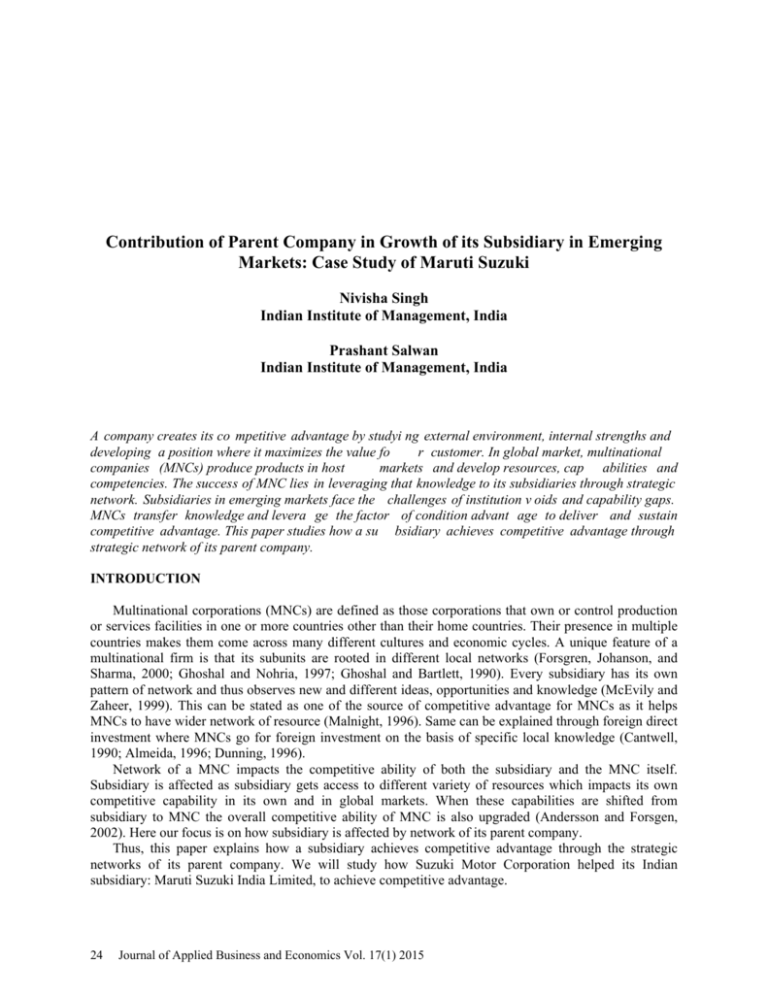
Contribution of Parent Company in Growth of its Subsidiary in Emerging Markets: Case Study of Maruti Suzuki Nivisha Singh Indian Institute of Management, India Prashant Salwan Indian Institute of Management, India A company creates its co mpetitive advantage by studyi ng external environment, internal strengths and developing a position where it maximizes the value fo r customer. In global market, multinational companies (MNCs) produce products in host markets and develop resources, cap abilities and competencies. The success of MNC lies in leveraging that knowledge to its subsidiaries through strategic network. Subsidiaries in emerging markets face the challenges of institution v oids and capability gaps. MNCs transfer knowledge and levera ge the factor of condition advant age to deliver and sustain competitive advantage. This paper studies how a su bsidiary achieves competitive advantage through strategic network of its parent company. INTRODUCTION Multinational corporations (MNCs) are defined as those corporations that own or control production or services facilities in one or more countries other than their home countries. Their presence in multiple countries makes them come across many different cultures and economic cycles. A unique feature of a multinational firm is that its subunits are rooted in different local networks (Forsgren, Johanson, and Sharma, 2000; Ghoshal and Nohria, 1997; Ghoshal and Bartlett, 1990). Every subsidiary has its own pattern of network and thus observes new and different ideas, opportunities and knowledge (McEvily and Zaheer, 1999). This can be stated as one of the source of competitive advantage for MNCs as it helps MNCs to have wider network of resource (Malnight, 1996). Same can be explained through foreign direct investment where MNCs go for foreign investment on the basis of specific local knowledge (Cantwell, 1990; Almeida, 1996; Dunning, 1996). Network of a MNC impacts the competitive ability of both the subsidiary and the MNC itself. Subsidiary is affected as subsidiary gets access to different variety of resources which impacts its own competitive capability in its own and in global markets. When these capabilities are shifted from subsidiary to MNC the overall competitive ability of MNC is also upgraded (Andersson and Forsgen, 2002). Here our focus is on how subsidiary is affected by network of its parent company. Thus, this paper explains how a subsidiary achieves competitive advantage through the strategic networks of its parent company. We will study how Suzuki Motor Corporation helped its Indian subsidiary: Maruti Suzuki India Limited, to achieve competitive advantage. 24 Journal of Applied Business and Economics Vol. 17(1) 2015 We have organized this paper in two parts. First we have explained various concepts: strategic networks, knowledge transfer, knowledge transfer in strategic networks and emerging economy multinational companies. Second, we have explained about Maruti and how Maruti evolved under the guidance and help of its parent company- Suzuki Motor Corporation. STRATEGIC NETWORKS Strategic networks are networks that can be observed between individuals, groups, or organizations, as well as between collectives of organizations. Gulati (2000) has defined strategic networks as firm’s set of relationships, both horizontal and vertical with other organizations. It can be suppliers, customers, competitors or other organizations. Network wants that its description and analysis not only concentrate on a section of the relationships that exist between the network participants and network relationships, but also on understanding the network completely (Anderson, Hakansson, and Johanson, 1994). The structure and intensity of the relationships ascertains the strategic network configuration (Burt,1979; Alba, 1982). In addition to formalized networks, the literature highlights the significance of informal networks as the consequences of and prerequisites for decision-making practices in organizations (Morgan, 1997; Sandner, 1990), the significance of the interdependence of actions spread across organization (Probst, 1987;Luhmann, 1988), and the effect of managers' positions in the internal network on their perception and processing of information (Walker, 1985). Reich (1991, p. 81), defines a firm as “a facade, behind which teams act as an array of decentralized groups and subgroups continuously contracting with similar diffuse working units all over the world''. Some authors have recognized strategic networks as a separate form of organization (Powell, 1990). However, in most cases they are looked as an amalgamation of organization between market and hierarchy (Thorelli, 1986; Siebert, 1991; Sydow, 1992), because they have elements of both. Strategic networks help us to understand structure of industry, as industry members can be seen as deep-rooted in networks of information, resources and various other sources. These networks can have an impact on the nature of competition in the industry and the amount of profitability that can be earned through traditional measures of industry concentration. For example it is easy to take advantage of tacit knowledge in tight network than in loosely connected network. KNOWLEDGE TRANSFER Knowledge transfer is the procedure where one strategy network member is affected by the experience, skills and knowledge of another (Argote & Ingram, 2000). Scholars often argue that firms which are capable of transferring knowledge efficiently from one firm unit to another are more successful than firms which are not (Almeida & Kogut, 1999; Argote, Beckman, & Epple, 1990; Baum & Ingram, 1998; Hansen, 2002; Kostova, 1999). Novel knowledge, especially knowledge external to organization, can be a significant motivation for transformation and development of an organization. Associated with network perspective more specifically, Kotabe, Martin, and Domoto (2003) establish that organizations do benefit from knowledge transfer that takes place between networks of firms. Gupta and Govindarajan (1991) propose that the multinational organizations can be considered as a network that consists of network of capital, product, and knowledge transactions between firms working in various countries. Thus, one of the primary reasons of survival of multinational organizations is their ability to transfer and utilize knowledge more successfully and efficiently in the competitive environment as compared to external market systems (Gupta & Govindarajan, 2000). In a parent-subsidy relationship, knowledge transfer from parent to its subsidiary helps subsidiary companies in several ways. First, subsidiaries might obtain knowledge valuable in the design and administration from its parent company (Lyles, 1988). This mutual know-how may be useful to the management of potential parent-subsidy relationship. Second, subsidiaries might obtain knowledge about other subsidiaries of same parent company that complements the firm's skill to handle the mutual task. Journal of Applied Business and Economics Vol. 17(1) 2015 25 The knowledge acquired can be vital to the development of new subsidiary (Arino & de la Torre, 1998; Doz, 1996). Third, subsidiaries can learn from its parent when they together enter a fresh business area and develop new capabilities. Last, subsidiaries attain knowledge about new skills and competencies that parent bring with it (Baum et. al., 2000; Kogut, 1988). Thus, from above perspectives we can say that parent companies provide opportunities to its subsidiaries to produce reusable knowledge (or private benefits), such as technological knowledge or market knowledge which help them to obtain competitive advantage. KNOWLEDGE TRANSFER IN STRATEGIC NETWORKS Knowledge is identified by today’s organizations as the most significant basis of achieving competitive advantage. Though, the key to obtain long-term competitive advantage is not in the management of existing knowledge, but in the ability to continuously create new knowledge, and to move to new products and services. Instead of seeing firms as devices to process information, make decisions, and solve problems, we need to understand that firms are based on seeking and creating knowledge. With regard to knowledge transfer in strategic networks, we believe two aspects are crucial. First, knowledge transfer must include transfer of both kind of knowledge: explicit and tacit. Additionally, focus should be on how knowledge is created and transmitted. It is easy to transfer explicit knowledge but tacit knowledge can barely be entirely communicated and shared as it is embedded in personal experiences, subjective insights, ethics and thoughts. (Nonaka and Takeuchi, 1995). Thus, in order to efficiently utilize knowledge, a strategic network needs to be created in which both the knowledge and the experience of employees are present. Most important is to encourage participants of network to participate actively in creation and sharing of knowledge and not just in accumulation of it (Seufert, 1997). In conclusion, in spite of whether network is created to obtain access to new knowledge, or to develop and transmit knowledge, connectivity to a network and ability to manage networks have become main drivers of new business logic. EMERGING ECONOMIES’ MULTINATIONAL COMPANIES In this paper we have tried to explore how the business relational embeddedness of a parent company impacts the market performance of its subsidiary. We are studying how knowledge transfer between parent and subsidiary helps subsidiary to sustain its competitive advantage in the host and home country. Present literature on knowledge transfer in strategic networks focus more on developed country. Emergence of some multinational companies of developing countries such as Brazilian airplane manufacturer, Chinese telecommunication manufacturers as world market leaders and acquisitions by these MNCs in developed country such as acquisition of Dutch steel producer by Indian conglomerate TATA, has shifted focus on study of these emerging economies’ multinational companies. Before we study these emerging economies’ multinational companies it is very necessary to understand how they are different from developed economies’ multinational companies. Emerging economies’ multinational companies are characterized by lower level of social growth especially in terms of income, health and education; this induces these MNCs to go for innovation. These emerging economies’ multinationals have less complicated innovation systems, not so developed capital markets and fewer developed suppliers. They have poor infrastructure but young working population. All this leads to emergence of firms having fewer patents, less sophisticated financial structures and internalization of suppliers of inputs at home. This encourages these MNCs to expand abroad to avail sophisticated technology. Challenging political conditions at home equips these MNCs to enter and dominate countries with turbulent governance conditions. Since, these MNCs are late entrant in markets therefore they expand not only in home and emerging economies but also in developed economies to come at par with their competitors of developed economies’ MNCs. 26 Journal of Applied Business and Economics Vol. 17(1) 2015 We will be studying a subsidiary of a Multinational company in an emerging economy and how this company sustained its competitive advantage. We decided to study Suzuki Motor Company’s subsidiary in India in longitudinal set up and to choose single case study method to study how Suzuki Motor Corporation has impacted its Indian subsidiary- Maruti Suzuki India Limited (MSIL). CASE STUDY METHOD Though there is enough debate over selection of case study as a research method but presently it is gaining importance and popularity among practitioners and scholars (Eisenhardt, 1989; Perry 1998; Romano, 1989). Case Study method is appropriate for building a deep understanding of new phenomena (Eisenhardt, 1989). In this paper case study method provides an analysis of the relationship and impact of a parent company on its subsidiary. Single Case Study This is a single case study. The objective of this study is to provide a holistic view of how Suzuki’s network helped MSIL to achieve competitive advantage. This required learning about the nature, evolution and management of network which was very demanding so single study was the best option. As mentioned by Easton (1995) single case study becomes not only necessary but also unavoidable in study of network processes as it is complex, context specific and requires study of large number of actors. Even Yin (1994) proposed that single case studies are best to verify or challenge a theory, or to signify an exclusive or extreme case. Thus, we used single case study to observe how network of a parent company helped its subsidy to survive and perform in competitive environment. Case Study Method History Case study method became popular during 1900 in Anthropology discipline. First generation of cases appeared in Chicago School of Business (Platt 1992). Case study was very popular till Second World War after that more importance was given to various quantitative methods. With the invent of various quantitative techniques and databases, qualitative research methods such as case study became less popular (Mitchell,1983; Platt, 1992). Case study again started gaining popularity in 1980s but only in education sector. Now case study is one of the common research strategy used in various journals under methodology section. Several authors (Yin 1989,1993; Eisenhardt, 1989; Hamel, Dufour, and Fortin 1993; Harley 1994; Stake 1995; Silverman 2000) played an important role in popularizing case study method. Limitations of Case Study Case study is often doubted for validity, reliability and generalization. Yin (1994) defines each of these as follows: Construct validity requires setting up of correct operational measures for the concepts to be studied. Validity is further divided into two: internal and external. Internal validity requires creating a causal relationship where certain conditions are depicted as leading to other, as different from spurious relationships, whereas external validity defines the area to which the findings of the study can be generalized. Reliability of a case study is established when the processes of the study such as data collection procedure can be applied again and again giving the similar results. He also suggested methods through which each of these can be obtained. Yin (1994) suggested that construct validity can be ensured using multiple source of data. Here we used multiple sources of date: company’s website, documents and news paper articles to ensure construct validity. He has further mentioned that internal validity can be guaranteed by specifying the unit of analysis. This is required as theories are developed, data is collected and analysis test is done to test theories all of which revolve around unit of analysis. Therefore, in our paper we specified the subsidy (i.e. MSIL) as unit of analysis and all theories, concepts, and analysis revolve around it. Yin (1994) has said it is hard to establish external validity in single case study. This could be attained from theoretical relationships and from these generalizations could be done which will also resolve generalization Journal of Applied Business and Economics Vol. 17(1) 2015 27 problem. In our paper we tried to build a connection between strategic network and knowledge transfer so that same phenomenon can be observed in other situations also. Levy (1988) used single case study method to study impact of information technology at the University of Arizona. He established both construct and internal validity using the single case exploratory design and the single case explanatory design respectively. Why Case Study? Case study provides a multi-sided view of a particular situation in its context. It is supposed to be a best methodology where thorough analysis is required (Feagin, Orum and Sjoberg, 1991). It offers indepth and comprehensive understanding of a particular phenomenon (Easton, 1995). It gives a chance to be near to the studied items which allows inductive and detail description. It is preferred in new situations where not much is known and in situations where present theories seem inappropriate (Easton, 1995; Eisenhardt, 1989; Yin, 1989). In case of change processes it is considered to be a strong method as it permits study of both related factors and process elements in the same existing life. Even Valdelin (1974) has proposed that in-depth observation made in case studies provides a chance to study different features and establish a relation between features and their environment in which they operate. These advantages make it evident that case study method is most appropriate to study networks. Therefore, we have used case study as a research methodology in this paper. Some other authors who have used case study method in study of networks are Vyas and Woodside (1984), they used multiple case studies to study selection of vendors by business-to-business customers, Hutt, Reingen, & Ronchetto (1988) used exploratory single case study and analysis of network to observe the communication process that happens during the formulation of marketing strategies, finally, Buckles and Ronchetto (1996) also used the same study as that of Hutt et.al. to understand business-to business exchange behavior in detail. It is believed that Yin & Eisenhardt possess wide experience in this methodology and are often cited therefore we decided to use their description of case study in this study. Yin (1984) notes three types of case study that is exploratory, descriptive and explanatory case studies. Exploratory case studies investigate any phenomenon in the data which is of interest to the researcher. Descriptive case studies explain the natural phenomenon that takes place within the data in question. Explanatory case studies observe the data carefully both at a surface and at a deep level to explain the trend. Here we used exploratory case study method as the emphasis is on investigating how a parent company helped its subsidiary to achieve competitive advantage. Eisenhardt’s (1989) model of building theory from qualitative case study is used as an inspiration in this paper. As Eisenhardt (1989) explained case study as a strategy that focuses on understanding the dynamics present in a single setting, pursuing relations between theory and data gathered; so we have integrated same concept in this paper. AUTOMOBILE SECTOR IN INDIA: AN OVERVIEW Till early 1980s automobile sector in India was controlled by government. There were two major players in the market: Premier Automobiles Limited which had product by name Premier Padmini and Hindustan Motors Limited which used to make Ambassador Car. The entire scenario of the Indian market changed because of licensing policy relaxation and entrance of Maruti Udyog Limited (MUL) in 1983. (Kale, 2010) Maruti Suzuki India Limited Maruti Udyog Limited (MUL) was established in 1981 under the provisions of Indian Companies Act, 1956 but the production started in 1983. The main purpose was to modernize automobile industry in India, to produce fuel efficient vehicles and native utility cars and to meet the growing demand caused because of lack of efficient public transport system and increased purchasing power. Indian government entered into a joint venture with Suzuki Motor Corporation (SMC) of Japan because of SMC’s expertise in manufacturing and selling small cars across world. A license and a joint 28 Journal of Applied Business and Economics Vol. 17(1) 2015 venture were signed between MUL and SMC in Oct 1983. Suzuki got 26% stake in equity and agreed to provide the latest technology and well known practices of Japanese management. SMC’s equity was revised from time to time, first to 40% in 1987 and then to 50% in 1992. Finally, in 2002 Indian government decided to give charge of management of MUL to SMC for a consideration of Rs. 1, 000 crore. By 2002, government had 49.76%, SMC had 50% and employee’s trust had 0.24% stake in MUL. By the end of 2003, after government sold 27.5% of its stake to public to collect money (approx 990 crores) and after right issue SMC’s stake increased to 54.2 % in MUL. Now, government had 45.54% stake in MUL. On May 10, 2007, India government sold its entire share to Indian financial institutions. Now government does not have any stake in Maruti Udyog. In July, 2007 Suzuki changed the name of its Indian subsidiary to Maruti Suzuki India Limited. Reforms in Government Policies in Indian Automobile Sector Before liberalization Indian automobile sector was controlled by government. Foreign companies’ participation was restricted by government through high import tariffs and other strict measures. Hindustan Motors and Premier Automobiles ruled the automobile sector. With the arrival of Mahindra and Mahindra, TATA Motors, and Bajaj Auto in 1950s there was an increase in production of vehicles. Thus, 1960s saw the establishment of automobile sector in India. With the introduction of Maruti Udyog in 1980s there was a tremendous increase in automobile industry. The only FDI player allowed to enter the Indian market was Suzuki Motor Corporation of Japan. In 1983 government allowed SMC to have joint venture with MUL, a state owned enterprise during that time. (Nagaraj, 2003) After ten years during 1990s, government relaxed various norms after liberalization and de-licensed manufacturing of passenger cars and opened it for foreign enterprises. This encouraged various foreign companies’ participation and today almost all world renowned automobile companies have their presence in India. (Nagaraj, 2003) Changes in Competitive Environment After liberalization various global champions of automobile sectors started coming to India. Government also encouraged these companies by relaxing various norms and formulating new policies. All this increased vehicle production from just 10,000 in 1950 to 10 million in 2006. This also increased competition in this segment. Government reduced excise duty by 8% on the manufacture of compact cars which led to an increase of automobile players in this segment. According to Indian government there were two major requirements that need to be fulfilled by a car to fall in compact car segments. These requirements were first that engine capacity of a car should not be more than 1200 cc and length should not be more than 4000 mm. Companies started making cars as per these conditions to avail the benefits of 8% excise reduction. Many cars launched during this period have engine with capacity of 1197cc and lengths were just below 4000 mm. Some of the examples are: Hyundai’s i20, Honda Jazz, and Fiat’s Punto. Maruti also responded to competition by launching Ritz and redesigning the Swift’s engine (which was originally 1300 cc) so that it falls under this category. An Overview of Business Activities of Maruti Suzuki India Limited Maruti Suzuki India Limited (MSIL) is a subsidiary of Suzuki Motor Corporation (SMC) of Japan. Its main functions are manufacturing and distributing passenger cars and spare parts. To facilitate the same it has two manufacturing facilities in India: one at Gurgaon and other at Manesar. To manufacture diesel engine and transmissions for cars, Maruti Suzuki has diesel engine plant in Manesar: Suzuki Powertrain India Limited. It is a joint venture between SMC and Maruti Suzuki India Limited with SMC holding 70% equity share. MSIL offers various ranges of cars such as luxury, sports utility and multipurpose cars. Company offers entry-level cars for each of these segments such as Maruti 800, Alto, Ritz, A star, Swift, Wagon R, Estillo and Eeco under family cars segment; DZire and SX4 Journal of Applied Business and Economics Vol. 17(1) 2015 29 under luxury cars; and Grand Vitara under sports utility cars segment so that customers of each income level can purchase one. It’s not only affordable cars but also various service businesses such as TrueValue, Maruti Insurance and Maruti Finance and MSIL's N2N (End to End) fleet management system that has made Maruti a popular brand and a leader in automobile industry. Company’s sales network consists of 1421 outlets spread across 1097 cities in India. MSIL also provides maintenance support to customers through 3060 service stations spread across 1454 cities of India. Change in Indian Society IT and BPO booms in India led to an emergence of wealthy upper middle and middle class with greater purchasing power. There was a change in the mindset of people because of education and urbanization. Increase in awareness led to an increase in expectations too. Now, small cars were no longer considered a luxury. This was also visible in sales of Maruti’s models. There was an increase in number of models offered by Maruti in 1990. Now, Maruti 800 was looked as an entry car by those who wanted to upgrade from a two wheeler to a four wheeler and do not have much budget to invest on a car. This increase in purchasing power and changed mindset of consumers encouraged automobile owners to come up with new and different models. Mini sized cars were getting replaced by midsized or compact cars. Cars with higher capacity, increased prices of fuel, easy loans at reasonable interest rates provided by banks and other financial institutions affected the purchasing decision of Indian consumers and thus the sale of cars. MARUTI SUZUKI’S STRATEGIES TO FACE COMPETITION Till 1998 Maruti was the leader in the automobile utility-car segment sector. But with an increase in competition from both local players (TATA, Mahindra & Mahindra, Hindustan Motors) and foreign players (GM, Mitsubishi, Ford, Toyota etc.), entire structure of automobile industry was changed and Maruti started losing its market share and profit. To regain its position Maruti adopted strategic response. Some of these are discussed below: Operational Efficiency and Reduction in Cost Producing 85-90 % of all its models in India helped in cost reduction. Maruti’s plan of reducing cost, increasing productivity and quality and improving technology led to economies of scale. Suppliers and vendors provided more than 80% of the car and rest was manufactured in-house. This helped Maruti to bounce back with 40% profit in FY 2002-2003. Targeting Customers of each Price Segment Maruti used a penetration strategy by catering to all segments through product offering at all price points. As discussed earlier Maruti has affordable cars in each segment (family, luxury and sports utility). 70% of Maruti’s business comes from repeat purchase. Diversification Maruti tried to reach customers not only through an increase in production or quality but also through various customer centric ventures. It developed various revenue generating ventures without making huge investments. This also helped Maruti to retain customers. Some of these ventures are: 1) Maruti Finance Maruti Suzuki Finance acted as a one shop stop for customers by looking after their entire vehicle finance related needs. To provide customers easy loans Maruti Suzuki Finance tied-up with 37 finance partners such as SBI, HDFC, ICICI, Bank of Baroda, etc, which had a pan India presence. This provided a wide variety of options to customers who could take loan from any of these as per their convenience. Maruti also participated in various sales promotion schemes, low interest rate, low down payment, etc. to attract customers. 2) Maruti Insurance Maruti Insurance offered special motor insurance products from leading insurance companies such as National Insurance, New India Assurance, ICICI Lombard, Iffco Tokio and Royal Sundaram and Bajaj 30 Journal of Applied Business and Economics Vol. 17(1) 2015 Allianz to bring all insurance needs under one roof. This provided instant policy issuance, hassle-free, fair and transparent claim settlement, quality repairs, and easy transfer of no claim bonus to its customers. 3) Maruti Genuine Accessories Maruti has over 1600 accessories for all the models to make driving more comfortable and enjoyable. This helped customer to give personal touch to their car. 4) Maruti Genuine Parts Under this service Maruti Suzuki ensured that during any wear and tear and replacement, parts provided remain like the original. Company has a huge set of dealers and service stations to help customers with genuine parts. 5) True Value Maruti True Value is India’s largest certified, used car dealer network. It was started in 2001. Here every vehicle brought is inspected and certified by Maruti Suzuki engineers, are refurbished in state of art workshops using Maruti Genuine parts. These cars are then sold through Maruti True Value outlets with one year warranty and three free services. Presently it has 763 True Value Outlets across 550 cities. It provided reassurance to existing Maruti customers about resale of their cars. It ensured fair and transparent transactions. It helped to extend the emotional connect and relationship that company enjoyed with its customers. 6) Wide Service Network MSIL has deepest and widest service network in India. About 40, 000 cars are serviced in a day. Maruti has 3060 service stations across 1454 cities with 33,000 strong trained professionals to provide fast and immediate service. An online feedback form was provided so that Maruti can improve its service in future. 7) N2N Leasing and Fleet Management System As the name suggests it takes care of all the end-to end needs of the corporate clients. It provided corporate clients hassle-free experience of owning the car through services such as leasing, maintenance, convenience services and re-marketing. Maruti Suzuki is the first company to tailor-make lease solutions for the corporate clients. Through this customers pay only for the usage of the asset, get zero depreciation policy for full accidental cover, emergency support services, hassle free resale of vehicles, and save more through VAT benefits under N2N leasing and save on income tax as rentals can be claimed as expense. 8) Maruti Driving School There is inhibition to purchase cars among Indian customers because most of them cannot drive car. To counter this problem Maruti started its own driving school. This helped in bringing customers to Maruti showrooms which often ended up in creating customers. It was started in 2005 in Bengaluru, India. It also took special initiative by having lady instructors for women learners. Today there are over 322 Maruti Driving Schools across nation and Maruti have trained and created 5 lakh better and more confident drivers so far. HOW SUZUKI MOTOR CORPORATION HELPED ITS INDIAN SUBSIDIARY MARUTI SUZUKI INDIA LIMITED IN ACHIEVING COMPETITIVE ADVANTAGE As discussed earlier Suzuki Motor Corporation gained majority stake in Maruti Udyog Ltd. India in 2002 and took over management control from government. By end of 2003 SMC had 54.20% stake in MUL and in 2010 government sold its entire share in MUL. Now, SMC has 56.2 % stake in MSIL. After the management of Maruti went into hands of Suzuki, faster decisions were made. To make swift decision, to respond quickly to environmental changes and to face competition, Suzuki adopted hierarchical approach. To remain ahead of its competitors, Maruti Suzuki implemented some of the popular management techniques of SMC such as supply chain and cost reduction methods. Suzuki also brought funds to Maruti and started major projects for new technology adaptation and capacity expansion. Some of the major help and guidance provided by Suzuki to its Indian subsidy are: Journal of Applied Business and Economics Vol. 17(1) 2015 31 Diesel Venture As discussed earlier how to be cost effective and to face growing local competition, a diesel plant was set up in Manesar. Suzuki Powertrain India Limited (SPIL) amalgamated with the Company, resulting in consolidation of the business of manufacturing engines, creating greater synergies between the businesses of both companies and their large asset base, and providing access to better financial resources. SPIL is a supplier of diesel engines and transmission systems to the company and is owned by Maruti Suzuki and SMC on a 30%-70% basis. This helped MSIL to bring its entire diesel engine capacity under a single management control and strengthen all aspects of business including sourcing, localization and production planning. Result was an increase in sale of diesel vehicles by 62% and an increase in company’s share from 19.2% to 25.2% in 2012-13. R&D Maruti decided to take advantage of SMC’s experience. MSIL’s R&D centre and test course at Rohtak, Haryana, is a state-of-the art facility, comparable to the best in the world. It also happens to be SMC’s first global R&D centre outside Japan. The Company’s R&D vision is to design and develop automobiles for India, Middle East, and African markets by the company on its own. It had R&D strength of 1300 engineers during 2013-14. Engineers got opportunity to participate in various projects with SMC to gain exposure, experience and learn their style of working. This helped MSIL to build talented workforce and boost the designing capability among R&D engineers. Company also participated in various projects such as it worked on hybrids and electric vehicle projects with SMC this enhanced cost effectiveness of parts and systems. R&D helped MSIL to launch more CNG models, new models, and refreshed version of existing models of Wagon R, SX4 and Ritz. Information Technology Information technology provides key support to various functions of the Company and also empowers the value chain with information. Efforts were made towards technology absorption, adaptation and innovation. Some of these efforts were: design of components and systems using a robust design review process, components and sub-components level localization, enhancement of evaluation capabilities, enhancement of software design, and value engineering during new model designing phase. All this led to high localization content in various vehicles, cost reduction, affordable new models, significant weight reduction of new models compared to existing models and improved fuel efficiency. International Presence Suzuki Motor Corporation’s reputation and presence across globe gave a good acceptability to MSIL abroad. MSIL’s products were well accepted at various parts of world. In 2012-13, the Company crossed a major milestone by exporting its millionth vehicle. Introduction of new models such as refreshed A-star, DZire, Ritz and new Alto 800 contributed to this milestone. In financial year 2013-14 export sales stood at 101, 352 units with about 72% contribution from nonEurope markets. During the year, non-Europe sales declined due to non-tariff barriers and political unrest in certain major markets. Company tried to offset this by introducing new products. Introduction of Swift and Dzire in South Africa helped achieve additional sales. MSIL exports to over 125 countries. It has presence in countries such as Algeria, Chile, UK, Indonesia, Peru, Netherlands, Egypt, Australia, Uruguay, Malaysia, Vietnam and Hungary including some of the unconventional markets such as Angola, Benin, Djibouti, Ethiopia, Morocco, Uganda, Costa Rica and El Salvador. IMPACT OF SUZUKI MOTOR CORPORATION ON MARUTI SUZUKI INDIA LIMITED Exhibit 1 shows how with the help of its parent company SMC, MSIL increased its competitiveness in global market and earned competitive advantage over its peers. It shows how collaboration of Suzuki with Maruti (India) is better that its collaboration with other countries. Columns marked with blue show 32 Journal of Applied Business and Economics Vol. 17(1) 2015 where Maruti (India) is better and column marked with orange where other collaboration or countries are better. EXHIBIT 1 MARUTI SUZUKI (INDIA) Vs ITS PEERS (Source: AOMA, Aranca Research) Figures taken from Sustainability Report also show sales (both export and domestic) have increased over the years. EXHIBIT 2 FINANCIAL PERFORMANCE FROMC2008-09 TO 2012-13 (Sustainability Report 2012-13) Journal of Applied Business and Economics Vol. 17(1) 2015 33 Though there was an increase in net sales as depicted in following exhibit but due to depreciation in economy and increased fuel prices, the prices of the vehicles were increased which decreased PAT in 2010-11 and due to natural calamity in 2012 in Japan i.e. Tsunami, PAT was further affected in 2011-12 which company tried to pick in 2013 but it was still lower than that of 2009-10. EXHIBIT 3 NET SALES & PAT FIGURES (Sustainability Report 2012-13) In following figures we can see that 2011-12 were affected because of Tsunami and Manesar violence. Manesar plant was shut down for a month in 2012 to control violence in plant and operation took three months to return to normal. EXHIBIT 4 CONTRIBUTION TO NATIONAL EX-CHEQUER AND R&D EXPENDITURE (Sustainability Report 2012-13) 34 Journal of Applied Business and Economics Vol. 17(1) 2015 Though there was a decrease in profit margins but book value and EPS remain unaffected and showed an increasing trend. EXHIBIT 5 PROFIT MARGIN AND BOOK VALUE AND EPS OF MARUTI SUZUKI (Sustainability Report 2012-13) Net worth and Reserve and Surplus of company also showed an increasing trend. This was because of launch of new models (such as Ertiga), refreshed models (Wagon R, Ritz and SX4), better availability of diesel models, and further expansion in rural markets. EXHIBIT 6 NET WORTH AND RESERVE & SURPLUS OF MARUTI SUZUKI (Sustainability Report 2012-13) Journal of Applied Business and Economics Vol. 17(1) 2015 35 EXHIBIT 7 OVERALL PERFORMANCE OF MARUTI TILL 2013 (Sustainability Report 2012-13) From above we can say that Suzuki helped MSIL to design cars to suit Indian market. Suzuki’s technology and R&D help helped MSIL to have cost leadership in domestic market. MSIL capitalized on Suzuki’s R&D capabilities and internal resource to finance its expansion. Now, MSIL has presence in almost all countries of world, thereby saving it from high borrowing costs and interest rates which helped it to be cost competitive and make significant presence and maintain it over a long period of time. Following figures give details of MSIL’s performance vis-à-vis its competitors for last three years. It is clearly visible MSIL is way ahead of its competitor in mini car, compact car, mid-sized car and overall car sales volume. EXHIBIT 8 MSIL WITH MAXIMUM SALES VOLUME IN MINI AND COMPACT CAR SEGMENT (2012-2014) (Source: Company, SIAM, IDBI Capital Research) 36 Journal of Applied Business and Economics Vol. 17(1) 2015 EXHIBIT 9 MSIL WITH MAX. SALES IN MID-CAR SEGMENT EXHIBIT 10 MSIL’S SALES VOLUME Vs. OTHER CARS PRODUCER IN ALL CARS SEGMENT (Source: Company, SIAM, IDBI Capital Research) Journal of Applied Business and Economics Vol. 17(1) 2015 37 AWARDS AND RECOGNITION Trust Research Advisory, a brand analytics company, in its Brand Trust Report ranked MSIL at 37th position in 2013 and at 11th position in 2014 among the most trusted brands of India. Some other awards and recognitions are: MSIL was recognized as India’s Most Respected Automobile Company by business magazine Business World in 2007, Hall of Fame award for single handedly changing the face of Indian automobile industry by Car India in 2011, Customer Responsiveness award in 2006 and 2007 by The Economic Times and Avaya Global Connect Limited, Company of the Year award in 2010-11 by Business Standard, Golden Peacock Award in various categories in various years such as for excellence in environment management in 2007 and for sustainability and Occupational Health & Safety performance in 2012. MSIL ranked 91 in Forbes magazine’s list of 200 most reputed companies in 2006. In 2005 under automotive sector, MSIL ranked 7th in the world. Maruti Suzuki Service has been No.1 in the J D Power Customer Satisfaction Award for 14 years in a row. Some major achievements in 2013-14 were: 1,155,041 vehicles sold in 2013-14 1st in both JD customer and sales satisfaction index study 16% growth in rural sales in 2013-14 3,36,463 vehicles sold in 93,500 villages in 2013-14 4 out of five top selling models in the country are from Maruti Suzuki 1st in pre-owned car business in India VRIO FRAMEWORK Barney (1991) who made popular resource based view has said that for any organization to achieve sustainable competitive advantage, advantage which cannot be immediately copied, duplicated or implemented by competitors it is necessary that resources including firm attributes, capabilities, various organizational processes, information, assets, knowledge, etc., owned by organization need to be valuable. A resource is said to be valuable when it helps organization to employ strategies that improve its competence and effectiveness. Resource also needs to be rare i.e. it is not owned and easily accessible by competitors, inimitable i.e. it cannot be copied by other players and finally organization i.e. whether the organization is ready to exploit resource/ capability. The organization must have all the systems and practices in place to so that it can bear the maximum benefits from the exploitation of the resource. We have depicted through VRIO framework how the help provide by Suzuki Motor Corporation to its Indian subsidiary-MSIL lie under above four parameters. CONCLUSION The knowledge transfer (sharing of best management practices, technology, R&D practices, etc.) through strategic network of SMC and MSIL provided help and guidance to MSIL in almost all areas such as R&D, technology, management, etc. Thus, MSIL improved its profit and regained its lost position in domestic market. Here the various strategic networks were observed in almost all functions of MSIL such as between the engineers, management of SMC and MSIL, and MSIL and SPIL to name a few. Today, Maruti is present in all parts of the world. SMC helped Maruti in upgrading its technology and workforce. Company’s manufacturing operations have improved now and meet the internal parameters of quality, productivity and cost. 38 Journal of Applied Business and Economics Vol. 17(1) 2015 In spite of the volatility in the market and switch of demand among petrol and diesel vehicles, the company produced vehicles as per the market demand by making optimum utilization of facilities. This became possible only because of technology up-gradation and funds influx by SMC. MSIL has launched 36 new and refreshed models in past six years in India. Changing customer preference and increased competition presented new challenges in front of MSIL. Company maintained and strengthened its goodwill among its customers. To retain its present customer and acquire new one MSIL started various loyalty programs such as Auto card which provided various facilities to MSIL’s customers on their repeated dealings with the company. Company also offers 14 brands over 150 variants. Today, MSIL alone makes 1.5 million Maruti Suzuki cars every year. That’s one car every 12 seconds. Above discussed help and guidance provided by Suzuki Motor Corporation keeping in mind the Indian customers and market have helped MSIL to face global and local competition. MSIL has a team of over 1000 engineers who by working shoulder to shoulder with Team Suzuki have added many achievements to company’s portfolio. MSIL has the widest network across nation. It has 3060 service stations across 1454 cities with 33000 strong trained service professionals and 1421 sales outlets across 1097 cities that are always ready to help and serve customers. Thus, above case gives an understanding of how a parent company benefits its subsidiary to achieve competitive advantage over others. Knowledge transfer through strategic networks helps an emerging economy subsidy to take advantage of technology advancement of its parent company. Maruti took an advantage of excellence, quality and technology of Suzuki and established itself as a reliable and successful brand in India. Various accolades in various categories are example of this. It is a leader in domestic market and a well recognized name in international market. Its presence in 125 countries Journal of Applied Business and Economics Vol. 17(1) 2015 39 including highly competitive and mature European auto markets like the Netherlands, Germany, France, Italy and UK proves the same. It has also started penetrating the Indian rural market and has shown a promising growth there. For 30 years MSIL has been able to offer products in tune with the changing aspirations of Indian customers. This all happened because of superior technology, R&D, and financial help provided by SMC which helped MSIL to remain cost-efficient. This study can further be extended by studying the contribution of SMC in growth of MSIL’s rural growth. This study provides a good example of parent-subsidy relationship to students, managers, and policy makers. Managers and policy makers can consider this while making strategies or policies for an emerging economy subsidiary. REFERENCES Alba, R. D. (1982). Taking Stock of Network Analysis: A Decade`s Results. Research in the Sociology of Organizations, 39-74. Almeida, P. (1996). Knowledge Sourcing by Foreign Multinationals: Patent Citation Analysis in the U.S. Semiconductor Industry. Strategic Management Journal, 17, 155–165. Almeida, P., & Kogut, B. (1999). Localization of Knowledge and Mobility of Engineers in Regional Networks. Management Science, 45, 905-917. Anderson, J.C., Hakansson, H., & Johanson, J., (1994). Dyadic Business Relationships within a Business Network Context. Journal of Marketing, 58 (4), 1-15. Andersson,U., Forsgren, M., & Holm, F., (2002). The Strategic Impact of External Networks: Subsidiary Performance and Competence Development in the Multinational Corporation. Strategic Management Journal, 23, 979-996. Argote, L., Beckman, S. L., & Epple, D. (1990). The Persistence and Transfer of Learning in Industrial Settings. Management Science, 36, 140-154. Argote, L., & Ingram, P. (2000). Knowledge Transfer: A Basis for Competitive Advantage in Firms. Organizational Behavior and Human Decision Processes, 82, 150-169. Arino, A., & Torre, J. (1998). Learning from Failure: Towards an Evolutionary Model of Collaborative Ventures. Organization Science, 9, 306-325. Barney, J.B. (1991). Firm Resources and Sustained Competitive Advantage. Journal of Management, 19, 99–120. Baum, J. A., Calabrese, T., & Silverman, B. S. (2000). Don't Go it Alone: Alliance Network Composition and Startups' Performance in Canadian Biotechnology. Strategic Management Journal, 21, 267294. Baum, J. A., & Ingram, P. (1998). Survival-enhancing Learning in Manhattan Hotel Industry. Management Science, 44, 996-1016. Bonoma, T. (1985). Case Research in Marketing: Opportunities, Problems, and a Process. Journal of Marketing Research, 12, 199-208. Buckles, Tom A., & Ronchetto, John R. Jr. (1996). Examining an Industrial Buyer’s Purchasing Linkages: A Network Model and Analysis of Organizational Buying Workflow. Journal of Business & Industrial Marketing,11(6), 74–92. Burt, R. (1979). A Structural Theory of Interlocking Corporate Directorates. Social Networks, 2, 415-35. Campbell, D. (2008). Harvard Business School Case –Changan Automobile Co Ltd Cantwell, J. (1990). A Survey of Theories of International Production. London: Routledge. CRISIL. (2013). Indian Automobile Industry in 2012-13, CRISIL Research. Doz, Y. L. (1996). The Evolution of Cooperation in Strategic Alliances: Initial Conditions or Learning Processes? Strategic Management Journal, 17, 55-84. Dunning , J.H. (1996). The Geographical Sources of the Competitiveness of Firms: Some Results of a New Survey. Transnational Corporations, 5(3), 1–29. 40 Journal of Applied Business and Economics Vol. 17(1) 2015 Easton G. (1995). Business Marketing: An Interaction and Network Perspective . Norwell (MA): Kluwer Academic Publishing. Eisenhardt, K.M. (1989). Building Theories from Case Study Research. Academy of M anagement Review, 14(4), 532-550. Feagin, J., Orum, A., & Sjoberg, G. (1991). A case for case study. Chapel Hill, NC: University of North Carolina Press. Forsgren, M., Johanson, J., Sharma, D. (2000). Development of MNC Centers of Excellence . London: Macmillan Press. Ghoshal, S., & Bartlett CA. (1990). The Multinational Corporation as an Interorganizational Network. Academy of Management Review, 15(4), 603–625. Ghoshal, S., & Nohria N. (1997). The Differentiated MNC: Org anizing Multinational Cor poration for Value Creation. San Francisco, CA: Jossey-Bass. Gilmore, A. & Carson, D. (1996). Integrative Qualitative Methods in a Service Context. Marketing Intelligence and Planning, 14 (6), 21-26. Glasser, B.G. & A.L. Strauss. (1967). The Discovery of Grounded Theory Strategies for Qualitative Research. Chicago: Aldine. Gulati, R., Nohria, N., & Zaheer, A. (2000). Strategic Networks. Strategic Management Journal, 21, 203215. Gupta, A. K., & Govindarajan, V. (1991). Knowledge Flows and the Structure of Control within Multinational Corporations. Academy of Management Review, 16, 768-792. Gupta, A. K., & Govindarajan, V. (2000). Knowledge Flows within Multinational Corporations. Strategic Management Journal, 21, 473-496. Hamel, J., S. Dufour, & Fortin, D. (1993). Case study methods. London: Sage. Hansen, M. T. (2002). Knowledge Networks: Explaining Effective Knowledge Sharing in Multiunit Companies. Organization Science, 13, 232-248. Hartley, J. F. (1994).Qualitative methods in organizational research: A practical guide, London:Sage. Hirschman, E.C. (1986). Humanistic Inquiry in Marketing Research: Philosophy, Method, and Criteria. Journal of Marketing Research, 23, 237-249. Hutt; Michael, D.; Reingen, Peter H., & Ronchetto, John R. Jr. (1988). Tracing Emergent Processes in Marketing Strategy Formation. Journal of Marketing, 52, 4–19. Kale, D., (2010). Making Innovation Work for Society. Unpublished Conference Paper, University of Malaya, Malasia. Kaplan, R.S. (1986).The Role of Empirical Research in Management Accounting. Accounting, Organization and Society, 11(5), 429-452. Kogut, B. (1988). Joint Ventures: Theoretical and Empirical Perspectives. Strategic Management Journal, 9, 319-332. Kostova, T. (1999). Transnational Transfer of Strategic Organizational Practices: A Contextual Perspective. Academy of Management Review, 24, 306-324. Kotabe, M., Martin, X., & Domoto, H. (2003). Gaining from Vertical Partnerships: Knowledge Transfer, Relationship Duration, and Supplier Performance Improvement in the U.S. and Japanese Automotive Industries. Strategic Management Journal, 24, 293-316. Levy, S. (1988). Information technologies in univers ities: An institutional case study. Unpublished doctoral dissertation, Northern Arizona University, Flagstaff. Luhmann, N.(1988). Die Wirtschaft der Gesellschaft. Frankfurt: Suhrkamp. Lyles, M. A. (1998). Learning among Joint Venture Sophisticated Firms. Management International Review, 28, 85-97. Malnight, T.W. (1996). The Transition from Decentralized to Network-based MNC Structures: An Evolutionary Perspective. Journal of International Business Studies, 27(1), 43–65. Maruti Suzuki India Limited. Maruti Suzuki Limited. (2008). Annual Report 2007-08, Maruti Suzuki Limited. Maruti Suzuki Limited. (2013). Annual Report 2012-13, Maruti Suzuki Limited. Journal of Applied Business and Economics Vol. 17(1) 2015 41 McEvily, B., & Zaheer, A. (1999). Bridging Ties: A Source of Firm Heterogeneity in Competitive Capabilities. Strategic Management Journal, 20(12), 1133–1156. Merriam, S.B. (1988). Case Study Research in E ducation: A Qualitative Approach. San Francisco: Jossey-Bass. Mitchell, C. (1983). Case and Situation Analysis. Sociological Review, 31(2), 187–211. Morgan, G. (1997). Images of organization. Calif: Sage Publications. Morgan, G. & L. Smircich. (1980). The Case for Qualitative Research. Academy of Management Review, 5, 491-500. Nagaraj, R., (2003). Foreign Direct Investment in India in the 1990s: Trends and Issues. Economic and Political Weekly, 38(17), 1701-1712. Nonaka, I., & Takeuchi, H. (1995). The Knowledge-creating Company: How Japanese Companies Create the Dynamics of Innovation. New York: Oxford University Press. Orlikowski, W.J. & J.J. Baroudi. (1991). Studying Information Technology in Organizations: Research Approaches and Assumptions. Information Systems Research, 2(1), 1-14. Parkhe, A. (1993). Messy Research, Methodological Predispositions, and Theory Development in International Joint Ventures. Academy of Management Review, 18(2), 227-268. Platt, J. (1992). Case Study in American Methodological Thought. Current Sociology, 40(1), 17–48. Powell, W., Koput, K., & Smith-Doerr, L. (1996). Interorganizational Collaboration and The Locus of Innovation: Networks of Learning in Biotechnology. Administrative Science Quarterly, 41, 11645. Powell, W. (1990). Neither Market nor Hierarchy: Networks forms of Organization. Research in Organizational Behavior, 12, 295-336. Probst, G. J. (1987). Selbstorganisation. Hamburg: Parey. Reich, R. B. (1991). The work of nations: Preparing ourselves for 21st-century capitalism . New York: A.A. Knopf. Sandner, K. (1990). Prozesse der Macht: Zur Entstehung, Stabilisierung und Veränderung der Macht von Akteuren in Unternehmen. New York: Berlin. Schlesinger, L. A. ( 2000). Harvard Business School Case – Automobile Dealer Sales & Service: Critical Incidents. Seufert, A. (1997). Groupware-enabled Data Warehouse. M anagement Support fuÈ r die p rofessionelle Knowhow Organisation PruÈ fungs- und Beratungsgesellschaft . Dissertation Thesis, University of St. Gallen, Switzerland. Siebert, H. (1991). OÈ Konomische Analyse von Unternehmungs Netzwerken. Managementforschung, 291-311. Sinharay, S. (2010). Strategies of Maruti-Suzuki in Response to Changes in Business Environment in India. Unpublished Research Work, IMT Ghaziabad, India. Silverman, D. (2000). Doing Qualitative Research: A practical Handbook. London: Sage. Stake, R.E. (1978). The Case Study Method in Social Inquiry. Educational Researchers, 7, 5-8. Stake, R. (1995). The Art of Case Study Research. Thousand Oaks, CA: Sage. Sydow, J. (1995). Organisation von Netzwer ken: Strukturationstheoretische Analysen der Vermittlungspraxis in Versicherungsnetzwerken. Opladen: Westdt. Verl. Thorelli, H. B. (1986). Networks: Between Markets and Hierarchies. Sloan Management Review, 7, 3751. Vyas, Niren, & Woodside, Arch G. (1984). An Inductive Model of Industrial Supplier Choice Processes. Journal of Marketing, 48, 30–45. Walker, G. (1985). Network Position and Cognition in a Computer Software Firm. Administrative Science Quarterly, 30, 103-30. www.moneycontrol.com www.ingovern.com Yin, R.K.(1984). Case Study Research: Design and Methods. Calif: Sage Publications Yin, R. K. (1989). Case Study Research Design and Methods. Sage: Newbury Park. 42 Journal of Applied Business and Economics Vol. 17(1) 2015 Yin, R. K. (1993). Applications of Case Study Research. Sage Publications, Newbury Park, CA. Yin, R. K. (1994). Case Study Research: Design and Methods, Sage Publications, Thousand Oaks, CA. APPENDIX (Source: Annual Report 2013-14) (Source: Annual Report 2013-14) (Source: Annual Report 2013-14) (Source: Annual Report 2013-14) Journal of Applied Business and Economics Vol. 17(1) 2015 43 (Source: Annual Report 2013-14) (Source: Annual Report 2013-14) (Source: Annual Report 2013-14) 44 Journal of Applied Business and Economics Vol. 17(1) 2015 (Sustainability Report 2012-13)


